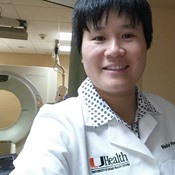Program Information
Dosimetric Validation of a Partially-Shielded Gd-153 Brachytherapy Concept
X Li1*, Q Adams2, R Flynn3, University Of Iowa, (1) Department of Physics & Astronomy (2) College of Medicine (3) Department of Radiation Oncology, Iowa City, IA
Presentations
SU-C-16A-4 Sunday 1:00PM - 1:55PM Room: 16APurpose: To demonstrate by measurement that using partially shielded Gd-153 sources for rotating-shield brachytherapy (RSBT) is feasible. RSBT is a potentially superior alternative to conventional high-dose-rate brachytherapy and provides the opportunity to dramatically improve tumor dose conformity for the treatment of, for example, prostate cancer.
Methods: A custom-built, stainless steel encapsulated 150 mCi Gd-153 capsule with an outer length of 12.8 mm, outer diameter of 2.10 mm, active length of 9.98 mm, and active diameter of 1.53 mm was used. A partially shielded catheter was constructed with a 500 μm platinum shield and a 500 μm aluminum emission window, both with 180° azimuthal coverage. An acrylic phantom was constructed to measure the dose distributions from the shielded catheter in the transverse plane using Gafchromic EBT3 films. Film calibration curves were generated from 50, 70, and 100 kVp x-ray beams with NIST-traceable air kerma values to account for energy variation.
Results: The transmission ratios of platinum to aluminum shielding at 1 cm off-axis are 7.5% and 7.6% for Monte Carlo (MCNP5) predicted and experimental results, respectively. The predicted/measured relative dose rates at 1 cm, 2 cm and 3 cm off-axis through the Al window were 100%/92.9%, 28.6%/27.0% and 13.8%/12.7%, respectively. Through the Pt shield, the predicted/measured relative dose rates were 7.5%/7.1%, 3.8%/3.0% and 2.4%/1.7%, respectively.
Conclusion: Using partially-shielded Gd-153 sources for RSBT is a promising approach to improving brachytherapy dose distributions. The next step in making Gd-153 based RSBT a reality is developing a Gd-153 source that is small enough such that the source, shield, and catheter all fit within a 16 gauge needle, which has a 1.65 mm diameter.
Funding Support, Disclosures, and Conflict of Interest: University of Iowa Research Foundation
Contact Email:


